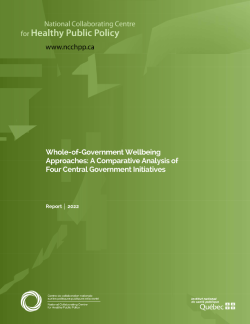Whole-of-Government Wellbeing Approaches: A Comparative Analysis of Four Central Government Initiatives
The wellbeing approaches studied, with their reference frameworks and associated wellbeing indicators, are policy instruments for the entire government apparatus. Although these approaches have only recently been introduced and have been the subject of few evaluations, they appear promising. They are based on a vision of social, human, economic and environmental progress and rely on measurements that complement those of economic growth and GDP. Their adoption is intended to support what matters most to people, namely their wellbeing.
The main features common to the wellbeing approaches of these central governments are:
- They are intended to be whole-of-government approaches, i.e., they involve the entire government apparatus, as well as other actors (departments, governmental and paragovernmental agencies, private sector actors, research groups, civil society, etc.).
- They view wellbeing as a multidimensional concept (e.g., with psychological, social, economic, and environmental dimensions) that is closely tied to both the concept of quality of life and the concept of progress, and that aligns with the OECD’s Better Life Initiative (2011).
- They rely on a wellbeing framework officially put forward by the government, which also includes a dashboard of wellbeing indicators that complement GDP. These indicators vary from country to country and serve as a guide to measuring the country's progress and success in different areas of wellbeing.
The main objectives pursued by the governments through these wellbeing approaches are to:
- Enhance the performance of the government apparatus by linking decision-making processes to requirements for outcomes that go beyond standard economic measures;
- Be transparent and accountable to the public for actions taken to ensure and promote the wellbeing of all;
- Ensure a better future and greater wellbeing for future generations, nature and the planet as a whole, through prevention, long-term planning and intersectoral action;
- Build on collaboration and the sharing of responsibility among various actors;
- Increase the country's prosperity and stimulate the economy;
- Take action to protect the environment, including from climate change, with a view toward sustainable development and resource sustainability;
- Affirm and promote cultural and national identities;
- Promote justice and equity for the entire population;
- Act in support of international solidarity and cooperation.
In addition to relying on a wellbeing framework, the governments use a variety of means to achieve their objectives. The main mechanisms for implementation, evaluation and accountability are:
- The drafting of various reports that are integrated in different ways into the policy cycles of the central governments;
- The integration of wellbeing indicators into national budgeting processes;
- The creation or use of public bodies whose mandate is to ensure the implementation and monitoring of the wellbeing approach;
- The development of tools, guides, policies, teams, or resources dedicated to building capacity for implementing the wellbeing approach;
- The mobilization of various social groups, the consultation of various experts and citizens, and the setting up of independent commissions;
- Public awareness and communication campaigns.


